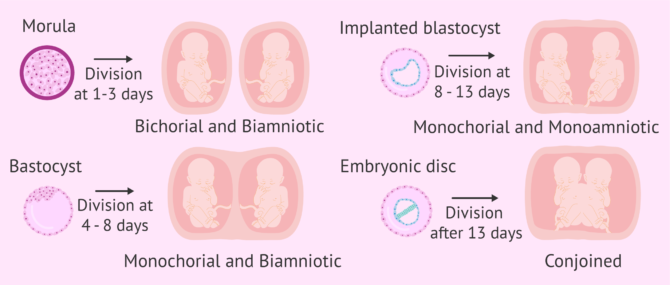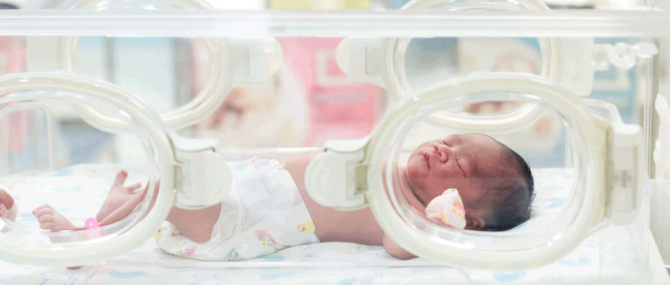Although a twin pregnancy is generally understood as any gestation of two embryos, we should know that identical twins are not the same as fraternal twins. Visibly there is an important difference in that identical twins are identical and of the same sex. In any case, both types of twins are considered higher risk pregnancies, since they present an increased probability of complications.
Double pregnancy is the most common form of multiple pregnancy, although sometimes we also see pregnancies with triplets, quadruplets, quintuplets.
These are not very common natural pregnancies, although they occur more frequently after in vitro fertilization treatment when more than one embryo is transferred. However, reproductive medicine is trying to curb the proliferation of this type of pregnancy.
Provided below is an index with the 9 points we are going to expand on in this article.
- 1.
- 2.
- 3.
- 4.
- 5.
- 6.
- 7.
- 7.1.
- 7.2.
- 7.3.
- 7.4.
- 7.5.
- 7.6.
- 7.7.
- 7.8.
- 8.
- 9.
Types of twin pregnancy
Multiple pregnancies occur as a result of different processes that will also determine the type of twins:
- Dizygotic twins: this occurs after the fertilization of more than one egg with different sperm. These are what we commonly know as fraternal or non-identical twins (or triplets, quadruplets, quintuplets, etc.). The children present physical resemblance but as with any other sibling. They can also have different sexes, depending on the sperm that fertilized them. Fraternal twins usually account for about 70% of cases of multiple pregnancy.
- Identical, monozygotic twins: arise from the division of the same embryo. As the babies have the same genetic material, they will be of the same sex and physically will be virtually identical. These account for approximately 30% of multiple pregnancies.
In turn, in the case of identical twins, we can further classify them according to the moment in which the embryo divided into two independent embryos. This will affect the placenta and the number of amniotes or sacs:
- Bi-chorionic-biamniotic pregnancy: the division occurs at the morula embryonic stage, before the fifth day of embryonic development. Each of the embryos will develop their own placenta and in an individual amniotic sac.
- Monochorionic-biamniotic pregnancy: embryo fragmentation occurs at the blastocyst stage (between days 4 and 8 of embryonic development). This results in one shared placenta and two amniotic sacs.
- Monochorionic-monoamniotic pregnancy: occurs when the division has taken place between day 8 and day 13 of development. In this case, both embryos share one amniotic sac and one placenta.
- Conjoined twins: the division occurs at an advanced stage of embryonic development and is therefore not complete. Both embryos grow in the same sac and the same placenta but in an anomalous way.
In the case of dizygotic embryos or twins, being two independent oocytes, they will evolve in two separate placentas and sacs. They are therefore bi-chorionic-biamniotic pregnancies.
Common risks
Mulitple pregnancy usually involves a series of risks for both the woman and the future babies. The following is a summary of the most common:
- Premature delivery
- Low birth weight.
- Preeclampsia.
- Increased fluid retention
- Delayed intrauterine growth.
- Gestational diabetes
- Chromosomal alterations: as such, genetic studies are recommended.
- Feto-fetal transfusion syndrome: occurs when one fetus receives more blood than the other. It occurs in monochorionic pregnancies and can be serious, although if detected in time there is a solution.
If you want more information about the possible risks, you can read this article: Risks in a multiple pregnancy.
Factors favoring multiple pregnancy
There are diverse factors that can increase the chances of having a multiple pregnancy, for example:
- Hereditary: passed on through the mother when the woman has a family history of this type of pregnancy. It can also occur if the father has a history of twins in the family but passes it on to the daughter. It is not necessarily true that it skips one, two or three generations, although it can happen.
- Age of the woman: when the woman is over 30-35 years of age at the time of gestation, there is a greater likelihood of multiple pregnancy. Hormonal alterations as menopause approaches may favor double ovulations.
- High body mass index (BMI): some studies indicate an increased likelihood of poliovulation in women with a BMI over 30.
- Assisted reproduction: fertility treatments have been responsible for many multiple pregnancies due to the artificial stimulation of ovulation and the transfer of more than one embryo. However, reproductive medicine is working to reduce this type of pregnancy.
- After continued use of contraceptive pills: some studies point to a possible rebound effect after taking the contraceptive pill.
In recent decades, multiple pregnancy rates associated with in vitro fertilization (IVF) treatments in which more than a single embryo is transferred have increased, hence the importance of single transfers whenever possible.
It is a common belief in many patients that transferring frozen embryos decreases this risk. Performing a delayed embryo transfer (with frozen embryos) or immediate embryo transfer (fresh) at the puncture does not decrease the rate of multiple pregnancies. This depends exclusively on the number of embryos transferred.
Symptoms of twin pregnancy
Although the evolution of a twin pregnancy is practically the same as that of a single pregnancy, there may be slight variations in terms of symptoms.
Women with this type of pregnancy tend to experience more nausea and vomiting than in a single pregnancy. The size of the uterus is also larger, which can cause more discomfort and a greater sensation of heaviness.
Therefore, it is important to follow the medical indications so that the twin pregnancy evolves month by month in a healthy way and allows the birth of healthy children. Some common recommendations to reduce potential risks and complications are:
- Rest: it is likely that the woman will require some additional tranquility to that required in a singleton pregnancy.
- Increased medical control: a greater number of ultrasound scans should be performed and you should visit your doctor more often than usual. An early diagnosis is important to know when then the pregnancy is to term to plan the delivery (although it does not necessarily have to so, it is very likely to be by cesarean section).
Once the babies are born, the mother will need all the help she can get to cope with raising two or more babies at once.
Twin pregnancy and assisted reproduction
To increase the chances of success of an assisted reproduction treatment, two embryos are usually transferred in an IVF procedure. In this way, we increase the probability that at least one of them will implant and result in gestation. However, there is a possibility that both will implant and result in a twin pregnancy.
Currently there are many studies focused on reducing double transfers to reduce the probability of twin gestation without affecting the pregnancy rate.
This research focuses on the selection of the best embryo, the one that offers the best guarantee of implantation, thus increasing the probability of pregnancy with a single transfer.
When we associate multiple pregnancy with in vitro fertilization, we must keep in mind that we are talking about fraternal twins and not monozygotic twins, although socially we tend to confuse both terms. The case of identical twins in assisted reproduction could occur with the same probability as for a natural pregnancy.
You can read more about this in the following article: Multiple pregnancy and assisted reproduction.
Video about on the difference between identical and fraternal twins
Michelle Emblenton, biochemist at inviTRA, summarizes in this video whether having twins is hereditary and what can influence i:
Dizygotic twins occur when two eggs are fertilized by two different sperm and the two resulting embryos implant into the mother's uterus. These are often known as fraternal twins or non-identical twins.
FAQs from users
Which specific risks or dangers are involved in a multiple pregnancy?
Although the potential risks for the fetuses and the mother are becoming increasingly controlled and less frequent, it is precisely in cases of multiple births where problems for the mother may raise, such as high blood pressure, diabetes, prematurity, problems at the time of delivery, etc.
As for the baby, the potential dangers are those related to prematurity, most of them considered as mild and transitional, although some may become a serious health issue.
What are the most significant signs and symptoms of a twin pregnancy?
Answer from Fertility Madrid
There is an increase in uterine volume, so the diaphragm moves into the thoracic cavity, decreasing respiratory capacity.
- Blood pressure increases
- Maternal heart rate increases (palpitations)
- Varicose veins appear and feet and ankles swell
- Increased hormone levels
- Increased salivation and constipation may occur
That is why at Fertility Madrid we are in favor of transferring a single embryo.
What are the symptoms of a twin pregnancy?
Michelle Emblenton, biochemist at inviTRA, tells us about the possible symptoms of a twin pregnancy.
The evolution of a twin pregnancy or a multiple pregnancy is basically the same as the evolution of a single pregnancy. However, with two babies it may be that some of the symptoms are more pronounced. You may experience more nausea or more fatigue. As you've got two babies growing in there, the uterus is going to be bigger and you may have more sensation of heaviness and fatigue, requiring a little bit more rest than usual. What is important in a multiple pregnancy is that you go to all of your regular checkups (and there will probably be more of them in a multiple pregnancy) to ensure that all of those factors we've talked about are under control and that the pregnancy is evolving healthily for both you and your babies. And don't forget that once those babies are born, which may be by a cesarean section or not (it depends on your individual case) you are going to need a little bit more help than those mothers who just have a single baby, so do be prepared.
How can I get pregnant naturally with twins?
There is no way you can ensure that a twin pregnancy will occur naturally, as it will depend on the probability that a woman will ovulate more than one egg in the same cycle or on the probability that the embryo will fragment and give rise to the development of two independent embryos.
What are the chances of twins with donor eggs?
The chances of twins with egg donation are higher than in normal IVF cycles using the woman's own eggs due to the young age of donors, which translates into very healthy oocytes. This is the reason why multiple embryo transfers are unadvisable.
On average, if more than one embryo is transferred, the likelihood of becoming pregnant with twins is about 40%, while the chances of carrying triplets or greater is roughly 4%.
How is a twin pregnancy detected?
The pregnancy test analyzes the level of beta-hCG in maternal blood to confirm or rule out pregnancy. A very high beta-hCG level in the first weeks of gestation raises the suspicion of a double pregnancy, but confirmation will be obtained when two gestational sacs are visualized on ultrasound or a double heartbeat is heard.
Is it possible to have fraternal twins sharing one placenta?
No, when the pregnancy is with fraternal twins (and not identical twins), each one comes from a different embryo and therefore each one will develop its own placenta and its own amniotic sac.
This is known as a bicorionic-biamniotic pregnancy.
Is multiple pregnancy hereditary?
Although the genetic basis for the hereditary probability of having twins is not yet currently understood, it is true that having cases of fraternal or identical twins in the family does increase the chances of having a multiple pregnancy.
This is especially true in the case of fraternaltwins, since it is likely that the probability of ovulating twice is inherited.
If you would like more information on the hereditary basis of twins, we recommend reading this article: Is having twins hereditary?
We make a great effort to provide you with the highest quality information.
🙏 Please share this article if you liked it. 💜💜 You help us continue!
References
ASRM American Society for Reproductive Medicine. (2013). Embarazo y Nacimientos Múltiples: Mellizos, Trillizos, o Mayor Número de Bebés. Guía para pacientes. Serie de información para pacientes. Comité de Educación del Paciente y el Comité de Publicaciones. Birmingham, Alabama.
ASRM American Society for Reproductive Medicine. Challenges of Parenting Multiples. Patient’s Fact Sheet. Birmingham, Alabama 35216-2809.
Barri, P. (1996) Are multiple pregnancies an inevitable consequence of AMP techniques, in Press.
Bryan E, Denton J, Hallett F. Guidelines for Professionals: Multiple Births and Their Impact on Families. London: Multiple Births Foundation, 2001
Craandjik, M., Helmerhorst, F.H., Koudstaal, J. et al, (1996) The influence of assisted procreation on the perinatal outcome of twin pregnancies. [Abstr. no. 859] Hum. Reprod., 11 (Abstr. Book 1), 40.
Dias T, Mahsud-Dornan S, Thilaganathan B, Papageorghiou A, Bhide A. First-trimester ultrasound dating of twin pregnancy: are singleton charts reliable? BJOG 2010; 117: 979–984.
Dr. Erika McAslan Fraser. Expecting twins, triplets or more? The healthy multiple pregnancy guide. Tamba - Twins & Multiple Births Association. Scottish registered charity SC041055.
Filicori, M., Cognigni, G.E., Arnone, R. et al. (1996) Is multiple pregnancy an unavoidable complication of ovulation induction? The case for pulsatile GnRH. Eur. J. Obstet. Gynecol., 65 (Suppl. 1), 519-521
González Merlo J. Obstetricia. 5ed. Barcelona: Masson; 2006. p. 478.
Instituto Mexicano del Seguro Social. Diagnóstico y manejo del embarazo múltiple. Guía de Práctica Clínica (GPC). Catálogo maestro de guías de práctica clínica: IMSS-628-13. Dirección de prestaciones médicas. Unidad de Atención Médica. Coordinación de Unidades Médicas de Alta Especialidad. División de Excelencia Clínica.
Khalil A, Rodgers M, Baschat A, Bhide A, Gratacos E, Hecher K, Kilby MD, Lewi L, Nicolaides KH, Oepkes D, Raine-Fenning N, Reed K, Salomon LJ, Sotiriadis A, Thilaganathan B, Ville Y. ISUOG Practice Guidelines: role of ultrasound in twin pregnancy. Ultrasound Obstet Gynecol 2016; 47: 247–263.
Lorenzo I, Herrera LA. El embarazo múltiple ¿es realmente un factor de alto riesgo obstétrico? Población y Salud en Mesoamérica. 2009 [citado 26 Ago 2009]; 6(2).
National Collaborating Center for Women’s and Children’s Health (UK). Multiple Pregnancy. The Management of Twin and Triplet Pregnancies in the Antenatal Period. Commissioned by the National Institute for Clinical Excellence. RCOG Press: London, September 2011.
National Collaborating Center for Women’s and Children’s Health. Multiple Pregnancy: Evidence Update. Commissioned by the National Institute for Clinical Excellence. NICE: Manchester, March 2013.
National Institute for Health and Clinical Excellence, clinical guideline 129, Issue date: September 2011: Antenatal care for women who are pregnant with twins or triplets. Version 1, published September 2013, due for review September 2016. MAT018.01.
Nijs, M. and Geerst, L. (1993) Prevention of multiple pregnancies in an IVF program. Fertil. Steril., 59, 1245-1250
Roest, J., Van Heusden, A. et al. (1997) A triplet pregnancy after IVF is a procedure related complication that should be prevented replacement of 2 embryos only. Fertil. Steril, 67,290-295
Salomon LJ, Cavicchioni O, Bernard JP, Duyme M, Ville Y. Growth discrepancy in twins in the first trimester of pregnancy. Ultrasound Obstet Gynecol 2005; 26: 512–516.
Senoz, S., Benchetrit, A. and Casper, R. (1997) An IVF fallacy multiple pregnancy risk is lower for older women. /. Assist. Reprod. Genet., 14, 192-198
Staessen, C. and Camus, M. (1992) The relationship between embryo quality and the occurrence of multiple pregnancy. Fertil. Steril, 57, 626-630.
The American College of Obstetricians and Gynecologists. Women’s Health Care Physicians. (2015). Frequently Asked Questions. FAQ188. Pregnancy. Copyright July 2015 by the American College of Obstetricians and Gynecologists.
Velazco A. Embarazo múltiple. En: Rigol Ricardo O. Obstetricia y Ginecología. La Habana. Editorial Ciencias Médicas; 2006. p. 173-6.
FAQs from users: 'What can I do to get pregnant with twins naturally?', 'Which specific risks or dangers are involved in a multiple pregnancy?', 'What are the most significant signs and symptoms of a twin pregnancy?', 'What types of twin pregnancy are there?', 'What are the symptoms of a twin pregnancy?', 'How is a twin pregnancy diagnosed?', 'How can I get pregnant naturally with twins?', 'What are the chances of twins with donor eggs?', 'How is a twin pregnancy detected?', 'Is it possible to have fraternal twins sharing one placenta?' and 'Is multiple pregnancy hereditary?'.
Authors and contributors

More information about Michelle Lorraine Embleton







Hi. My family has a history of twins, on both my mom and dad´s sides. Interestingly I got pregnant with triplets naturally. I didn´t know, but at 11 weeks I had a bleed and thought I was miscarrying. I found out then I had been pregnant with triplets but lost one. I now have a lovely healthy set of twins, one boy and one girl.
I love being a mom of twins, but my partner wants to have another baby. I am terrified I may get pregnant with triplets like before and I already have my hands full. I really do only want one baby!
Any help or advice appreciated.
Hi Teresa0781
Congratulations on your twins, and thank you for sharing your story.
It does indeed sound like you have a hereditary disposition for having mutiple pregnancies, and I understand your concerns for a furture pregnancy.
There are options available to ensure a single pregnancy. One option is to use IVF with single embryo transfer, although it is impossible to rule out the division of the blastocyst to form identical twins.
Another route you could consider would be mutilfetal pregnancy reduction, whereby the number of embryos is reduced to ensure only one baby develops. You can read more about this by clicking here.
I hope this helps and wish you the best for your future pregnancy.